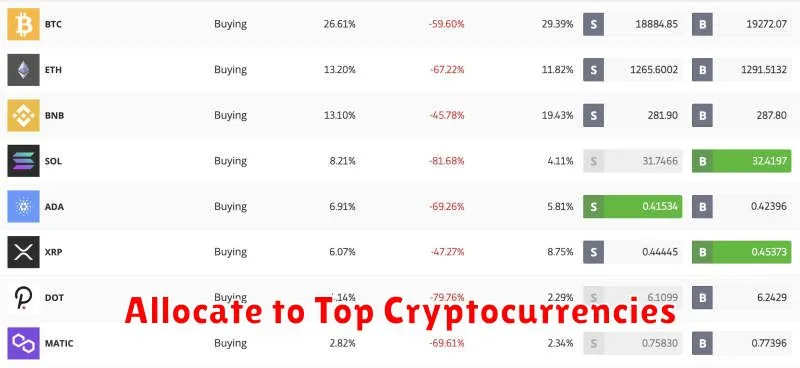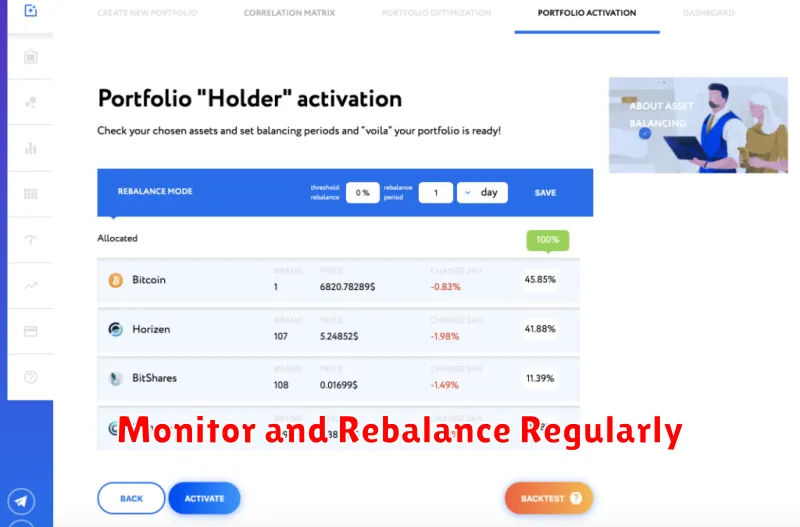Building a balanced crypto portfolio can seem daunting, but with a strategic approach, it’s achievable. This guide outlines five simple steps to help you diversify your cryptocurrency investments, mitigate risk, and potentially maximize returns. Learn how to carefully select crypto assets, understand market capitalization and volatility, and build a portfolio tailored to your risk tolerance and financial goals. Discover the key strategies for achieving a successful and balanced crypto portfolio.
Start with Stablecoins for Safety

Building a balanced cryptocurrency portfolio requires a strategic approach, and starting with stablecoins is a crucial first step for many investors. Stablecoins, pegged to a fiat currency like the US dollar, offer a relatively safe haven within the volatile crypto market.
Their price stability allows you to maintain the value of a portion of your investment while you explore more risky, potentially higher-reward assets. This approach reduces overall portfolio volatility and minimizes the impact of market downturns on your capital.
Think of stablecoins as your foundation. They provide a stable base from which to allocate funds into other cryptocurrencies according to your risk tolerance and investment goals. This measured approach helps you avoid impulsive decisions driven by fear or greed, a common pitfall in the crypto space.
By incorporating a stablecoin allocation, you can gradually build your portfolio, diversifying into other assets as you gain experience and confidence. This strategy promotes a more sustainable and responsible approach to crypto investing.
Remember to research different stablecoins and choose one backed by reputable collateral and audited regularly to ensure its stability and security. This is vital for maintaining the safety and value of your initial investment.
Allocate to Top Cryptocurrencies

Diversification is key in any investment portfolio, and crypto is no exception. Allocating to top cryptocurrencies by market capitalization is a common strategy to mitigate risk. This typically involves investing in established projects with a strong track record, like Bitcoin and Ethereum.
Consider the market capitalization of each cryptocurrency as a primary factor when making your allocation decisions. While larger market caps don’t guarantee future success, they generally suggest greater stability and liquidity.
Remember that even the top cryptocurrencies carry inherent risk. Market conditions can change rapidly, affecting the value of your holdings. Therefore, thorough research and a balanced approach remain crucial.
The percentage allocation to top cryptocurrencies will depend on your individual risk tolerance and investment goals. Some investors might allocate a larger portion to these established assets, while others may prefer a more diversified approach across multiple asset classes within the crypto market.
Regularly rebalance your portfolio to maintain your desired allocation. Market fluctuations will inevitably cause shifts in your asset percentages, so periodic adjustments are necessary to ensure your portfolio stays aligned with your initial investment strategy.
Diversify with Altcoins

Diversification is crucial in mitigating risk within your cryptocurrency portfolio. While Bitcoin and Ethereum dominate the market, limiting yourself to these top two significantly reduces potential gains and increases vulnerability to market fluctuations. Altcoins, or alternative cryptocurrencies, offer a diverse range of projects with unique technologies and use cases.
Including altcoins provides the opportunity for exposure to burgeoning sectors like DeFi (Decentralized Finance), NFTs (Non-Fungible Tokens), and the metaverse. Careful research is essential; not all altcoins are created equal. Some may offer high growth potential, while others might carry substantially higher risk.
A balanced approach involves allocating a portion of your portfolio (typically a smaller percentage than Bitcoin and Ethereum) to a selection of carefully vetted altcoins. Consider diversifying across different sectors to reduce risk and potentially maximize returns. It’s vital to understand the technology, team, and market potential of any altcoin before investing.
Remember, the cryptocurrency market is highly volatile. Diversifying with altcoins can help cushion the blow of potential losses in some areas while potentially benefiting from gains in others. Always conduct thorough due diligence and only invest what you can afford to lose.
Risk management is key. Avoid over-allocating to any single altcoin, and regularly review and rebalance your portfolio to adapt to changing market conditions. This strategy allows for a more balanced and potentially resilient investment approach within the broader cryptocurrency landscape.
Include Staking or DeFi Tokens

Integrating staking or DeFi (Decentralized Finance) tokens into your portfolio offers opportunities for passive income generation. This involves locking up your crypto assets in a staking pool or providing liquidity to DeFi protocols in exchange for rewards. These rewards typically come in the form of the native token of the platform, or sometimes a combination of tokens.
Careful selection is crucial. Research the platform’s reputation, security measures, and the tokenomics of the project. Consider the risks involved, including impermanent loss in liquidity pools and the potential for smart contract vulnerabilities. Diversification within this category is also advisable, avoiding over-exposure to a single platform or token.
Staking generally carries lower risk than DeFi liquidity provision. However, both strategies should be approached with a thorough understanding of the mechanics and associated risks. Only allocate a portion of your portfolio to this category, based on your risk tolerance and investment goals.
By thoughtfully incorporating staking or DeFi tokens, you can potentially enhance your portfolio’s returns and experience the benefits of active participation in the decentralized finance ecosystem. Remember that due diligence is paramount before engaging in any staking or DeFi activities.
Monitor and Rebalance Regularly

Regular monitoring is crucial for maintaining a balanced crypto portfolio. Market volatility necessitates consistent observation of your asset allocation. You should track the performance of each cryptocurrency in your portfolio against your initial allocation targets.
Rebalancing involves adjusting your portfolio to restore your target asset allocation. If one asset significantly outperforms others, causing an imbalance, selling a portion of the overperforming asset and reinvesting in underperforming ones helps mitigate risk and maintain diversification. The frequency of rebalancing depends on your risk tolerance and market conditions, ranging from monthly to quarterly or even annually.
Consistent monitoring allows for timely identification of potential problems, such as significant price drops in a particular asset, allowing for prompt adjustments to your strategy. This proactive approach contributes significantly to reducing potential losses and optimizing long-term returns within your risk parameters. Remember that regular adjustments based on market fluctuations are key to maintaining a well-balanced and resilient portfolio.
